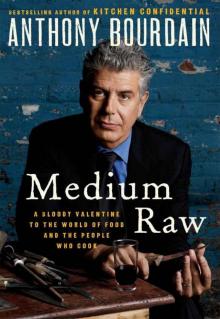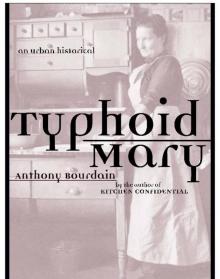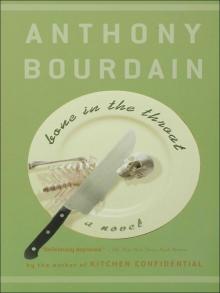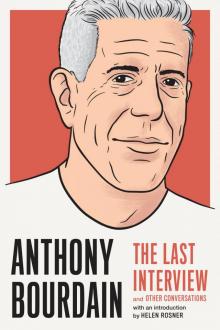- Home
- Anthony Bourdain
Typhoid Mary Page 7
Typhoid Mary Read online
Page 7
It has been said that Mary was not particularly fastidious. Was that hindsight – a conveniently comfortable retroactive musing from those left at the scene after the ambulances and hearses had departed?
What is clear is that the equipment, the mindset, and the personnel there all suggest an atmosphere of careful food handling. It’s not like the idea of washing your hands after visiting the bathroom was some goofy new theory. People were busily tearing up old floors and putting down tiles, ripping out wainscoting and filigree, doing away with curtains, putting up easy-to-wipe tin ceilings . . . stripping down their kitchens to make them cleaner, lighter, easier to work in – all in the name of cleanliness. Mary was probably dunking her hands in searingly hot water, ammonia and carbolic all the time. She wasn’t a stupid woman. What was wrong with her?
Chapter Seven
Exile Near Main Street
With Mary safely restrained at the Willard Parker Hospital, Dr. Soper felt more comfortable about paying her a visit. The first time he dropped by, he found her ‘curiously healthy’ and, unsurprisingly, ‘fearfully angry looking’.
‘Mary’, I said, ‘I’ve come to talk with you and see if between us we cannot get you out of here. When I have asked you to help me before, you have refused, and when others have asked you, you have refused them also. You should not be where you are now if you had not been so obstinate. So throw off your wrong-headed ideas and be reasonable. Nobody wants to harm you.’
When this speech made no impression on her, Soper continued:
‘You say you have never caused a case of typhoid, but I know you have done so. Nobody thinks you have done it personally. But you have done it just the same. Many people have been made sick and have suffered a great deal; some have died. You refused to give specimens that would help to clear up the trouble. So you were arrested and brought here and the specimens taken in spite of your resistance. They proved what I charged. Now you must surely see how mistaken you were. Don’t you acknowledge it?’
Mary just stared back silently (‘gleaming angrily’) at the sanitary engineer.
‘Well’, I continued, ‘I will tell you how you do it. When you go to the toilet, the germs that grow within your body get upon your fingers, and when you handle food in cooking they get on the food. People who eat this food swallow the germs and get sick. If you wash your hands after leaving the toilet and before cooking, there might be no trouble. You don’t keep your hands clean enough.’
Mary continued giving him the blank stare, but Soper persisted.
‘The germs are probably growing in your gallbladder. The best way to get rid of them is to get rid of the gallbladder. You don’t need a gallbladder any more than you need an appendix. There are so many people living without them.’
Mary’s eyes, according to Soper, widened slightly at this point.
‘Mary’, I continued, ‘I don’t know how long the Department of Health intends to keep you here. I believe that depends partly on you. I can help you. If you will answer my questions, I will do everything I possibly can to get you out. I will do more than you think. I will write a book about your case. I will not mention your real name; I will carefully hide your identity. I will guarantee that you will get all the profits. It will be easy for you to answer my questions. You know what I want to find out Above all, I want to know if and when you have had typhoid fever, and how many outbreaks and cases you have seen.’
Maybe a white-on-white cell was not the best environment to pitch Mary on a book deal. Especially when the proposed literary project involved discussion of her toilet practices, her habit of infecting people with typhoid and causing them to die, and the removal of her gallbladder. No small amount of self-incrimination would be required – and what decent person would want to read such a book? Maybe he should have taken her out to Rectors or Sherry’s before launching into his book proposal, showed her some nice cover art sketches – ones that made her look good. Surely that was, even then, the accepted approach. It’s hard to believe that even an unemployed carnival freak, Jo-Jo, The Dog-Faced Boy, for instance, would have looked kindly on such a deal under such circumstances, without even a free lunch and more seductive surroundings to help things go down easier.
Mary wasn’t interested in any damn book.
[She] rose. She pulled her bathrobe about her and, not taking her eyes off of mine, slowly opened the door of her toilet and vanished within. The door slammed . . . It was apparent that Mary did not intend to speak to me.
North Brother Island is a twenty-acre knob of glacial detritus which pokes out of the East River about twenty-five hundred feet west of Rikers Island. It’s just east of the Port Morris section of the Bronx, where the river takes a turn towards the Long Island Sound and the currents are nasty. Claimed by the Dutch West India Company in 1614, North Brother and its smaller sibling, South Brother, about five hundred feet southeast, were referred to as ‘The Companions’ until 1695, when the British government granted them to a Mr. James Graham. The two islands were left uninhabited for nearly two hundred years. In 1871, North Brother was sold to the town of Morrisania in the Bronx, which also did nothing with the space – surrounded as it was with treacherous waters. A lighthouse keeper and family were apparently the only residents until 1880.
In 1860, New York City’s population had soared to 813,669 people, an increasing percentage of that number consisting of Irish immigrants. Many of them were sick. Many of them were unruly. It’s fair to say that the wealthy and powerful men who ran things in those days weren’t too happy about all these foreigners pouring onto their shores and were eager for someplace to put them. Space was needed to put away the infected and infectious, the felonious, the indigent and the strange – preferably someplace where New York’s solid citizens wouldn’t have to see them. ‘Hulks’, or prison ships, had been used during the Revolutionary War – but with hideous results, so the government couldn’t simply float society’s undesirables offshore, say just over the horizon. Unused and unattractive pieces of real estate in the middle of the East River were the next best thing, it was thought, and first Blackwell’s Island, then Randall’s, Ward’s, Hart, North Brother, Rikers, and Ellis were being used to warehouse the unlovely. There is some reason to believe that these islands were already being used as a de facto refuge for typhoid, typhus and TB sufferers who’d been shunned or driven away by their neighbors.
North Brother Island first hosted a hospital and tent city for the Sisters of Charity to house typhus patients, but there was a more pressing need. Residents of small towns in Westchester were chasing smallpox victims into the city, unwilling and unable to take care of them themselves. Through various maneuvers of arm-twisting and ward-heeling, it appears, the city convinced the suburbs to build their own facility – a shack on the East River where they could pen up their sick. Unfortunately, when residents found that the one patient at the new place was black, they mobbed the place, set it on fire, and chased the patient and caretaker onto a boat. The two washed up on North Brother Island and squatted in an existing cottage.
In 1885, perhaps inspired by this example, the city built Riverside Hospital. They built it in a hurry, as there was a typhus epidemic going strong and it was anticipated that they would soon need the room. Staten Island wouldn’t play ball – the citizens of that island didn’t want any hospital filled with contagion carriers on their island. The other islands in the East River were already building other facilities, and the city had even had to build two islands (Hoffman and Swinburne) to keep up with demand for space. North Brother seemed the perfect out-of-sight, out-of mind place in which to quarantine the herds of typhus, cholera, yellow fever, and smallpox victims overflowing from other facilities. In 1898, the hospital began to be used primarily for Bronx residents – with exceptions made for matters of urgent need.
It was ugly. It looked, from above, like a ramshackle Alcatraz: At the outset, a two-story brick building for eighty patients, with three frame structures for forty each for busy times. It was
n’t enough. By 1900, tuberculosis was everywhere, killing thousands, and in 1903, two new buildings were erected and even that wasn’t enough. Over the next few years they continued building – the city even had to pour landfill into the river to make room for even more structures. If you were poor and talked with an accent and were unlucky enough to get tuberculosis, you might well find yourself at Riverside Hospital on North Brother Island.
North Brother was not a happy place. In 1904, three years before Mary Mallon was exiled there, the island was the site of its most notable tragedy; the fire on the 264-foot General Slocum excursion steamer. A witless deckhand had been careless with straw and on June 15, the second-worst fire in maritime history broke out in the storeroom, ultimately causing the deaths of 1,021 members of the German community who’d chartered the vessel to take them to Huntington, Long Island, for their seventeenth-anniversary picnic. Most of the passengers drowned, dragged down by faulty or fraudulent life preservers. Lifeboats were unusable or nailed to the decks, the firehoses rotted, and the captain, apparently, oblivious until it was too late. The ship in flames, with passengers falling and leaping into the current, the captain headed ashore at North Brother, the ship’s movement only fanning the flames and accelerating the destruction. Residents of the Bronx and New York paddled out to the scene in any available vessels, primarily to rob floundering Germans and to strip the dead. The living, still struggling in the rough water, were largely left to drown, or extorted for money before being rescued. More helpful were some prisoners from nearby Rikers Island, who actually swam over to help before returning to their cells. The charred and drowned bodies of 611 dead Germans were soon laid out in a row on the lawns of North Brother Island, with another 400 still bobbing in the river.
It was not an island with a happy history or an attractive present. It was about as far away from the world as a place could be and still be in New York. This was where Mary Mallon was banished in 1907. She was housed in a small bungalow which had once been home to the head of Riverside Hospital’s nursing department. It was situated at the southern end of the island and contained a living room, kitchen and bathroom and all the conveniences of the time: gas, electric and modern plumbing. It was, as Soper overgenerously describes it, ‘pleasantly situated on the river bank, next to the church.’
Her food was brought to her. She prepared it and ate it alone. Across the water she could see the city.
She was now serving an indefinite term of confinement. She had never been charged, indicted, tried, or convicted of any crime. Her face was in the newspapers; a sketch artist had come to Willard Parker and captured her image. The press had begun calling her ‘Typhoid Mary’. She was famous.
Chapter Eight
A Typical Cook
‘She is a large, healthy-looking woman, a typical cook, and there is nothing in her outward appearance to indicate that she is other than normal. She is, of course, segregated with the typhoid patients.’
So said Dr. William H. Park of the Board of Health. The statement was erroneous. Mary, at the time, was the lone typhoid patient on the island.
When we consider that she has been spreading the contagion for years, it is clear that she will be a prisoner on North Brother Island for a long time, perhaps for life; certainly until the (typhoid) germs and (typhoid) tendencies have been eliminated from her body.
Every effort has been made by the health authorities to cure the unfortunate woman, but so far without success. Examination is made each day with the hope that some one of the various expedients we have tried may put an end to the discharge of bacilli. Nothing we have tried so far has proved effective.
There is a later photograph of Mary at North Brother Island, huddled in a blanket among a row of similarly swaddled typhoid patients on the ‘sunny side’ of the pavilion. It looks like Stalag 17. The women sit close together as if sharing warmth. Their backs rest against a plain wooden wall, their feet on haphazardly lain-down planks to keep them out of the mud. What ‘expedients’ the doctors were trying on her to, as one paper put it, ‘dry up the fountainhead of typhoid germs in Mary Mallon’, is anybody’s guess. Medical literature of the time does not inspire confidence – nor can Mary’s limited experience with doctors so far have reflected well on the profession. She was a new phenomenon in the annals of typhoid. Doctors came to chat. They came to gawk. They came to suggest new treatments. And she listened to what the doctors and the nurses said, hanging, as patients do, on every word, analyzing the differences between their various recommendations, looking to glean something hopeful from the contradictions. The constant refrain continued to be the suggestion that she have her gallbladder removed. Would this cure the problem? No one could say with any assurance. It just seemed like a good idea, something they’d like to try – the preferred option from what must have seemed to Mary to be particularly unsympathetic, bumbling, and knife-happy jailers. She was not, it can also be said, popular with the other patients.
She was a cook. Who saw herself, as many cooks do, as slightly better than everybody else. Not higher on the evolutionary scale, nor better in the social sense of the word. Just harder-working, more skillful, more righteous. And she was, after all, a martyr of sorts. Identified in the press as the notorious Typhoid Mary, she was the subject of ribbing and gossip and speculation. She had little else to do with her time but stare out at the river, watch the world going on without her and recount the outrages committed against her good name and person. She had a lot of time to think – and was aggrieved and angry, and she did what any modern-day citizen with a gripe would do: she got herself a lawyer.
How Counselor George Francis O’Neill became involved in the case is unclear. He was a shrewd choice. Twice a Republican candidate for the state senate, prominent in Irish affairs, he had been, prior to taking the bar exam, a customs inspector, a man well versed in public health issues. There have been suggestions that the hidden hand of William Randolph Hearst is visible at this point in the story of Mary Mallon. Hearst, not unlike the quasi-portrait of him in the film Citizen Kane, had swept back into town by storm in 1895. In 1887, after a short stint working at The New York World, young William had convinced his dad, George, to buy him the San Francisco Examiner. When George kicked off in 1891, he left 17 million bucks to his wife, William’s mother, and William, already jacked on newspapers, immediately hit mom up for some dough – wanting desperately to return to New York and carve himself out some territory in the highly competitive newspaper business. Obligingly, mom sold off 7.5 million dollars worth of Anaconda Copper shares and gave the proceeds to her son. For the bargain price of 180,000 dollars, William Randolph Hearst bought himself the Morning Journal in 1895.
The early episodes of Citizen Kane, in spirit at least, portray pretty closely the real-life Hearst’s stint in New York. He wanted things. A lot of things. Among them was to be president of the United States. He set himself up as the advocate for the working man, the underdog, the downtrodden and the unfortunate, railing (at times fearlessly) against Tammany Hall politicians, social injustices, corruption, and inequity as he saw it. And he behaved, in public at least, with rectitude – never swearing, avoiding alcohol and tobacco.
There was one principal obstacle, however, one other pretender to the throne of Spokesperson for the Masses and Champion of Virtue; Joseph Pulitzer, whose own newspaper, the World, proudly crowed that it was the champion of the downtrodden. Hearst quickly began an energetic, no-holds-barred circulation war between his paper and Pulitzer’s, positioning himself, unashamedly, as the voice of the nation. His involvement in Cuban exile politics and his fomenting of war with Spain is well known. He was not, for instance, beyond fabricating alleged Spanish atrocities. Even Pulitzer saw a war with Spain as too good to miss out on and joined the fray, only ratcheting up the stakes. In the end, Hearst spent 7 million dollars trying to knock his rival out of the game, lavishing money on foreign correspondents, cables, and innumerable extra editions, most of which were returned for rebates. But in the end, b
oth papers ended up with a circulation of about a million and a quarter. Hearst’s Journal swallowed up the World and William got at least most of what he wanted, a loud and influential voice, a presence in national journalism and politics – and he used both assets with vigor.
He was sympathetic to the Irish, certainly. This was both tactically wise and seemingly heartfelt. Any imagined constituency would be largely Irish working class and have to, by necessity, include and appeal to the large numbers of public servants, politicians, Irish organization members, eating clubs and wardheelers who made the day-to-day of New York politics run smoothly and profitably. An editorial in the Journal-American on St. Patrick’s Day reveals a near-militant admiration for the cause of Irish republicanism and goes on to excoriate Americans for their relative gutlessness and compliance in the face of adversity and inequity.
And Journal-American coverage of the Mallon case was relatively restrained – even actively empathetic.
Did Hearst hire George O’Neill for Mary? Did Hearst see a continuing legal battle – pitting a hardworking Irish woman on one hand, and the monolithic Health Department with all their loosely defined powers to incarcerate and evict and restrain on the other – as a good thing for circulation? Somebody was being awfully nice. Or was it O’Neill himself – working pro bono perhaps? Hearst had provided lawyers for subjects of articles before – or helped organize fundraising for legal defense – and the Hearst papers’ coverage and access could certainly indicate a closeness to the case which other papers seem not to have enjoyed. Someone was paying for the services of the Ferguson labs.

 Medium Raw: A Bloody Valentine to the World of Food and the People Who Cook
Medium Raw: A Bloody Valentine to the World of Food and the People Who Cook The Bobby Gold Stories
The Bobby Gold Stories Gone Bamboo
Gone Bamboo Typhoid Mary
Typhoid Mary Bone in the Throat
Bone in the Throat Kitchen Confidential
Kitchen Confidential Anthony Bourdain: The Last Interview
Anthony Bourdain: The Last Interview Bobby Gold Stories
Bobby Gold Stories